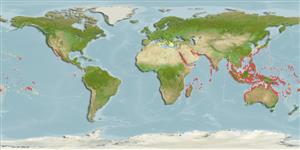Common names from other countries
Environment: milieu / climate zone / depth range / distribution range
Ecología
; rango de profundidad 0 - 20 m (Ref. 348). Tropical
Distribución
Países | Áreas FAO | Ecosistemas | Ocurrencias, apariciones | Introducciones
Indo-West Pacific and the Mediterranean: from East Africa, to Melanesia; north to South China and Taiwan Province of China and south to Indonesia; south and eastern parts of the Mediterranean. Tropical to subtropical climates.
Length at first maturity / Tamaño / Peso / Age
Maturity: Lm ? range ? - ? cm Max length : 12.0 cm SHL macho / no sexado; (Ref. 348); common length : 8.0 cm macho / no sexado; (Ref. 348)
Locally collected at low tide by coastal people when abundant (Ref. 348). Attached by their strong byssus to hard substrates where mud occurs, with the shell vertically disposed and the dorsal margin lying on the rock surface, or to the underside of ledges and boulders. Often in dense colonies (maximum recorded density of 870 individuals/m^2), sometimes forming mixed natural beds with Isognomon isognomum. Littoral and sublittoral (Ref. 348).
Life cycle and mating behavior
Madurez | Reproducción | Puesta | Huevos | Fecundidad | Larva
Members of the class Bivalvia are mostly gonochoric, some are protandric hermaphrodites. Life cycle: Embryos develop into free-swimming trocophore larvae, succeeded by the bivalve veliger, resembling a miniature clam.
Poutiers, J.M. 1998. (Ref. 348)
IUCN Red List Status (Ref. 130435)
CITES status (Ref. 108899)
Not Evaluated
Not Evaluated
Human uses
| FishSource |
Herramientas
Más información
Age/Size
Crecimiento
Length-weight
Length-length
Morfología
Larva
Abundancia
Fuentes de Internet
Estimates based on models
Preferred temperature
(Ref.
115969): 22.1 - 29.3, mean 28.2 (based on 4092 cells).
Vulnerability
Low vulnerability (10 of 100).
Price category
Unknown.
